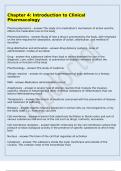Chapter 4: Introduction to Clinical
Pharmacology
Pharmacodynamics - answer-The study of a medication's mechanism of action and the
effects the medication has on the body
Pharmacokinetics - answer-Study of how a drug is processed by the body, with emphasis
on the time required for absorption, duration of action, distribution, and method of
excretion
Drug distribution and elimination - answer-Drug delivery systems, route of
administration, modes of excretion
Drug - answer-Any substance (other than food or device intended for use in the
diagnosis, cure, relief, treatment, or prevention of disease) intended to affect the
structure or function of the body
Pharmacology - answer-The study of medicine
Allergic reaction - answer-An acquired hyperresponse of body defenses to a foreign
substance
MAR - answer-Medication administration record
Anaphylaxis - answer-A severe type of allergic reaction that involves the massive,
systemic release of histamine and other chemical mediators of inflammation that can
lead to lifethreatening shock
Therapeutics - answer-The branch of medicine concerned with the prevention of disease
and treatment of suffering
Biologics - answer-Agents naturally produced in animal cells, by microorganisms, or by
the body itself. i.e., hormones, vaccines
Cell membrane - answer-A barrier that selectively facilitates or blocks entry and exit of
various substances into and out of the cell such as drugs, nutrients, and waste
Cell membrane receptors - answer-Specific molecules on the cell membrane surface that
produce or block biological activity in the presence of specific substances to which they
bind
Nucleus - answer-The brain of the cell that regulates all activities
Cytoplasm - answer-The substance inside the outer membrane and outside of the
nucleus. This contains most of the intracellular fluid
, Extracellular Fluid - answer-Body fluid located between or outside cells. Consists of
interstitial fluid or fluid between cells and intravascular fluid
Tissues - answer-A group of similarly specialized cells that perform the same function
Organs - answer-Specialized cells and tissues grouped together to perform a specific
body function for a common purpose
Muscle tissue - answer-The 3 types are skeletal, smooth, and cardiac.
Plasma - answer-The liquid portion of the blood that carries proteins and other
substances
Cardiovascular system - answer-Consists of the heart, the blood vessels, and the blood
itself. The body's main transportation system. It provides nutrients and hormones, and
removes waste from the cells
Respiratory system - answer-Consists of the nasal passages, the trachea, the diaphragm,
and the lungs. It performs the exchange of oxygen and carbon dioxide between the body
and the environment
Gastrointestinal system - answer-Consists of the mouth, esophagus, stomach, liver,
pancreas, gallbladder, and small and large intestines. Used by the body to acquire the
energy and nutrients it needs to sustain itself
Nervous system - answer-Consists of the brain and spinal cord and the peripheral
nervous system. This system conducts electrical signals throughout the body and allows
it to interact properly with its environment
Musculoskeletal system - answer-Consists mostly of the muscles, the bones, and other
minor systems. This system is primarily responsible for the body's basic frame support
and movement as well as its ability to perform physical work
Reproductive system - answer-Consists of the penis, testes, and seminal fluids and the
ovaries, oviducts, uterus, vagina and mammary glands. The system's major role is to
manufacture, transmit, and maintain the cells and environment necessary for
reproduction
Immune system - answer-Consists of the lymph nodes, vessels, and cells. Its major
purpose is to maintain the integrity of the body by attacking and removing invading
foreign substances and microbes. It also helps remove excess fluids from the body
Absorption - answer-How the drug passes from its site of administration into the
bloodstream
Distribution - answer-How the drug is dispersed among the organs of the body after it
absorbed into the bloodstream, and how much reaches the target organs




